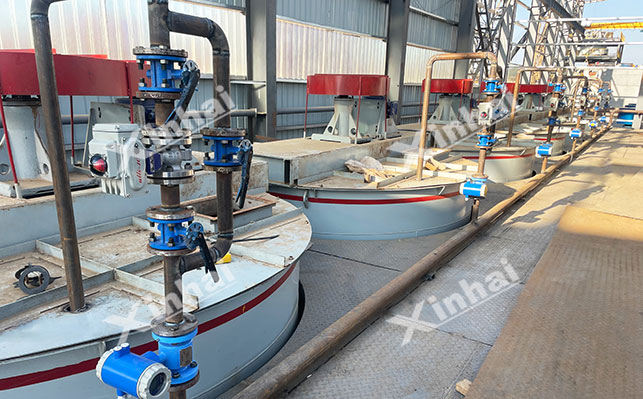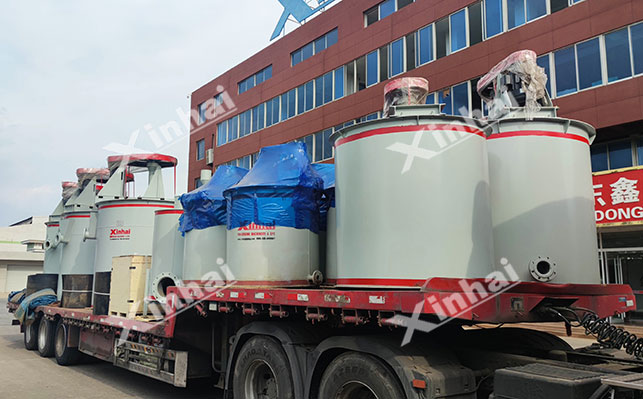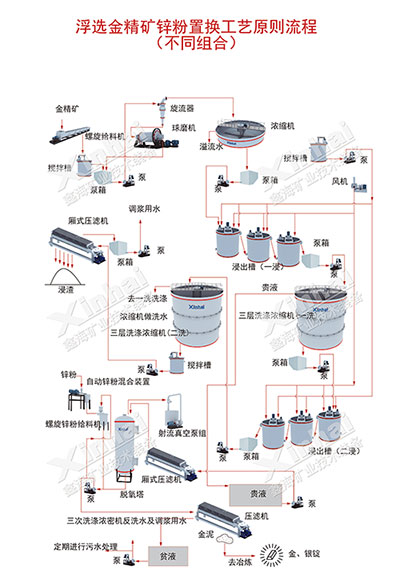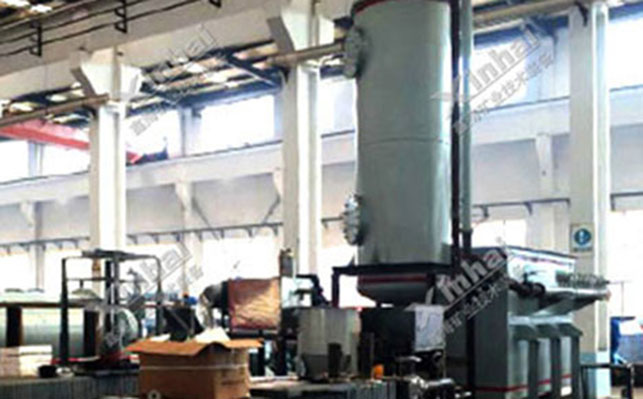
15311826613
Click to add WeChatGold cyanidation is an important and widely used gold extraction method, and it occupies a key position in the field of gold beneficiation. Its principle is based on the fact that gold will react chemically in the presence of oxygen in a cyanide solution to generate a soluble gold-cyanide complex, thereby achieving the separation of gold from gangue minerals. Cyanidation gold extraction can be divided into two methods: stirring cyanidation gold extraction and percolation cyanidation gold extraction. Among them, stirring cyanidation gold extraction has two types: zinc powder replacement method and carbon slurry gold extraction. This article will introduce the stirring cyanidation-zinc powder replacement gold extraction process.
Stirring cyanidation gold extraction is based on the reaction of gold with cyanide in a cyanide solution to generate a soluble gold-cyanide complex. By adding cyanide solution and stirring, the slurry and cyanide are fully mixed, and air is blown into the slurry to provide oxygen, so that gold is dissolved from the ore into the solution, and the initial separation of gold from gangue minerals is achieved.

The gold stirring cyanide leaching process is to feed the ore pulp after grinding into the leaching tank and mix it with the cyanide solution. Usually, the cyanide is sodium cyanide (NaCN) or potassium cyanide (KCN). At the same time, the ore pulp is strongly stirred by the stirring device to make full contact with the cyanide solution, and air is blown into the ore pulp to provide the oxygen required for the reaction. Gold reacts chemically with cyanide, and the generated gold cyanide complex dissolves in the solution. This link is the core step of the gold cyanide method. The purpose is to dissolve the gold in the ore into the solution to the maximum extent, realize the transfer of gold from solid ore to solution, and lay the foundation for subsequent gold recovery operations. The leaching effect directly affects the gold recovery rate, so the control of leaching conditions is particularly important.
The cyanide concentration is generally controlled between 0.03% and 0.1%. If the concentration is too low, the gold leaching speed is slow and the leaching rate is low; if the concentration is too high, the cost will increase and bring greater environmental risks. The pH value of the slurry needs to be maintained at around 10-11, presenting an alkaline environment to prevent cyanide from hydrolyzing to produce highly toxic hydrogen cyanide gas, while facilitating the dissolution reaction of gold. The leaching time is usually 24-48 hours, and the specific duration depends on factors such as the nature of the ore, the occurrence state of gold, and the leaching equipment. The stirring speed should be moderate, which can ensure that the slurry and the cyanide solution are fully mixed, but not too violent to cause ore particle wear or affect the reaction balance.

Common gold ore stirring cyanide leaching equipment includes leaching tanks, stirring devices, air agitators, etc.
Leaching tank: Generally an open or closed cylindrical structure, the material is mostly carbon steel lined with rubber or stainless steel to prevent corrosion from cyanide solution. The leaching tank can be selected in different specifications according to the production scale. Small-scale ore dressing plants may use a single or several smaller-volume leaching tanks, while large-scale ore dressing plants will use multiple large leaching tanks in series or parallel for continuous production.
Stirring device: There are two common methods: mechanical stirring and air stirring. Mechanical stirring drives the stirring blades to rotate through the motor, so that the slurry produces strong turbulence and promotes the mixing of solid, liquid and gas phases.
Air stirring device: It is to introduce compressed air into the bottom of the tank and use the rising bubbles to drive the circulation of the slurry.
Zinc powder replacement is a key step in extracting gold from gold-containing solution. Its principle is based on the redox reaction characteristics of metals. In the zinc powder replacement process, zinc powder is used as a reducing agent to achieve gold extraction by using the difference between zinc and gold in the metal activity sequence. The process is to stir the gold-containing solution after cyanide leaching and flow it into the replacement tank. Add zinc powder to the replacement tank. Since the metal activity of zinc is stronger than that of gold, a replacement reaction will occur. Zinc replaces the gold ions in the solution to generate metal gold precipitation. The precipitated gold particles and the unreacted zinc powder form gold mud.

The purpose of this step is to recover gold from the gold-containing solution and convert the gold dissolved in the solution into solid gold so that it can be purified by smelting and other methods to obtain finished gold. The efficiency and effect of the replacement process are directly related to the final recovery rate of gold and the quality of gold mud.
The quality and dosage of zinc powder have a significant impact on the replacement effect. Zinc powder with high purity and fine particle size should be selected. Generally, the amount of zinc powder added per ton of solution is between 0.5-2 kg. The specific dosage needs to be determined according to factors such as the gold content and impurities in the solution. In order to prevent the zinc powder from being oxidized during the replacement process, an appropriate amount of lead salt, such as lead acetate, is usually added to the solution. Lead salt can form micro-batteries on the surface of zinc powder to promote the replacement reaction of gold. The temperature of the solution is generally controlled at 15-35℃. If the temperature is too low, the reaction speed will be slow, and if it is too high, the dissolution loss and energy consumption of zinc powder will increase. In addition, the pH value of the solution must also be maintained in the alkaline range to ensure the smooth progress of the replacement reaction.
In addition to gold, the obtained gold mud also contains zinc powder, unreacted cyanide and other impurities. Therefore, the gold mud needs to be subsequently treated. First, the gold mud is separated from the solution by filtration, and then the gold mud is washed to remove residual cyanide and impurities. The washed gold mud is then smelted to separate the gold from other impurities at high temperature, and finally a high-purity finished gold product is obtained. The smelting process is generally carried out in a special furnace, and different processes such as pyrometallurgy or hydrometallurgy can be used. The specific choice depends on factors such as the nature of the gold mud and the scale of production.
Common zinc powder replacement equipment includes replacement tanks, feeding equipment, metering pumps, etc.

Replacement tank: also known as stirring tank, usually square or round, mostly made of carbon steel, with a stirring device inside to ensure that the zinc powder and the solution are fully contacted and reacted. A discharge port is provided at the bottom of the replacement tank to discharge the gold mud and the remaining solution. In order to improve the replacement efficiency, some modern replacement equipment will also adopt a countercurrent replacement method, that is, the gold-containing solution and zinc powder flow in reverse in multiple replacement tanks to make the gold replacement more sufficient. At the same time, the design of the replacement tank should be easy to clean and maintain to prevent the accumulation of gold mud and impurities in the tank from affecting the replacement effect.
Feeding equipment: The purpose is to ensure that the amount of zinc powder added always matches the amount of gold to be replaced in the solution to avoid waste or insufficient addition of zinc powder. Automatic screw feeders are often used, and the unit consumption of zinc powder can be reduced by 10%.
Metering pump: It is mainly used to control the flow rate of conveying liquid or powder. In the zinc powder replacement gold process, it is often equipped with special zinc powder conveying accessories to inject zinc powder evenly and stably into the gold-containing solution.
The above is an introduction to the process and related equipment of stirring leaching-zinc powder replacement gold extraction. In actual ore dressing plants, the properties of gold ores vary greatly, and the process methods used are also different. The final choice depends on the properties of the gold ore. Therefore, it is necessary to continue the ore dressing test analysis and design a suitable gold ore dressing plan.